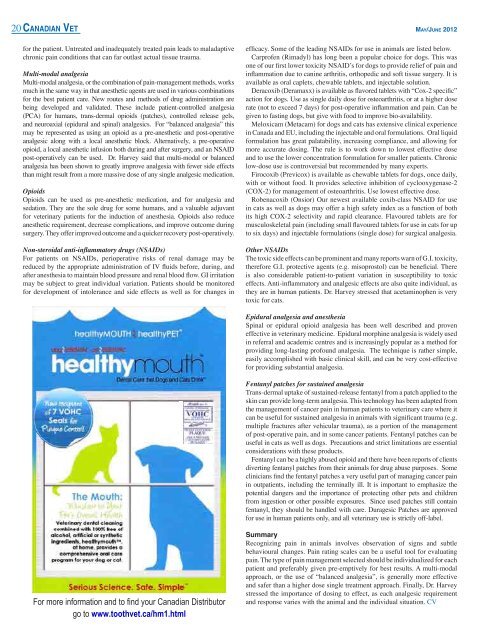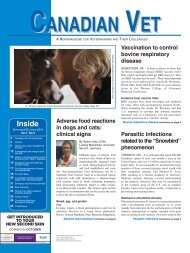canadian vet - K2 Animal Health Publishing
canadian vet - K2 Animal Health Publishing
canadian vet - K2 Animal Health Publishing
Create successful ePaper yourself
Turn your PDF publications into a flip-book with our unique Google optimized e-Paper software.
20 Canadian Vet<br />
May/June 2012<br />
for the patient. Untreated and inadequately treated pain leads to maladaptive<br />
chronic pain conditions that can far outlast actual tissue trauma.<br />
Multi-modal analgesia<br />
Multi-modal analgesia, or the combination of pain-management methods, works<br />
much in the same way in that anesthetic agents are used in various combinations<br />
for the best patient care. New routes and methods of drug administration are<br />
being developed and validated. These include patient-controlled analgesia<br />
(PCA) for humans, trans-dermal opioids (patches), controlled release gels,<br />
and neuroaxial (epidural and spinal) analgesics. For “balanced analgesia” this<br />
may be represented as using an opioid as a pre-anesthetic and post-operative<br />
analgesic along with a local anesthetic block. Alternatively, a pre-operative<br />
opioid, a local anesthetic infusion both during and after surgery, and an NSAID<br />
post-operatively can be used. Dr. Harvey said that multi-modal or balanced<br />
analgesia has been shown to greatly improve analgesia with fewer side effects<br />
than might result from a more massive dose of any single analgesic medication.<br />
Opioids<br />
Opioids can be used as pre-anesthetic medication, and for analgesia and<br />
sedation. They are the sole drug for some humans, and a valuable adjuvant<br />
for <strong>vet</strong>erinary patients for the induction of anesthesia. Opioids also reduce<br />
anesthetic requirement, decrease complications, and improve outcome during<br />
surgery. They offer improved outcome and a quicker recovery post-operatively.<br />
Non-steroidal anti-inflammatory drugs (NSAIDs)<br />
For patients on NSAIDs, perioperative risks of renal damage may be<br />
reduced by the appropriate administration of IV fluids before, during, and<br />
after anesthesia to maintain blood pressure and renal blood flow. GI irritation<br />
may be subject to great individual variation. Patients should be monitored<br />
for development of intolerance and side effects as well as for changes in<br />
efficacy. Some of the leading NSAIDs for use in animals are listed below.<br />
Carprofen (Rimadyl) has long been a popular choice for dogs. This was<br />
one of our first lower toxicity NSAID’s for dogs to provide relief of pain and<br />
inflammation due to canine arthritis, orthopedic and soft tissue surgery. It is<br />
available as oral caplets, chewable tablets, and injectable solution.<br />
Deracoxib (Deramaxx) is available as flavored tablets with “Cox-2 specific”<br />
action for dogs. Use as single daily dose for osteoarthritis, or at a higher dose<br />
rate (not to exceed 7 days) for post-operative inflammation and pain. Can be<br />
given to fasting dogs, but give with food to improve bio-availability.<br />
Meloxicam (Metacam) for dogs and cats has extensive clinical experience<br />
in Canada and EU, including the injectable and oral formulations. Oral liquid<br />
formulation has great palatability, increasing compliance, and allowing for<br />
more accurate dosing. The rule is to work down to lowest effective dose<br />
and to use the lower concentration formulation for smaller patients. Chronic<br />
low-dose use is controversial but recommended by many experts.<br />
Firocoxib (Previcox) is available as chewable tablets for dogs, once daily,<br />
with or without food. It provides selective inhibition of cyclooxygenase-2<br />
(COX-2) for management of osteoarthritis. Use lowest effective dose.<br />
Robenacoxib (Onsior) Our newest available coxib-class NSAID for use<br />
in cats as well as dogs may offer a high safety index as a function of both<br />
its high COX-2 selectivity and rapid clearance. Flavoured tablets are for<br />
musculoskeletal pain (including small flavoured tablets for use in cats for up<br />
to six days) and injectable formulations (single dose) for surgical analgesia.<br />
Other NSAIDs<br />
The toxic side effects can be prominent and many reports warn of G.I. toxicity,<br />
therefore G.I. protective agents (e.g. misoprostol) can be beneficial. There<br />
is also considerable patient-to-patient variation in susceptibility to toxic<br />
effects. Anti-inflammatory and analgesic effects are also quite individual, as<br />
they are in human patients. Dr. Harvey stressed that acetaminophen is very<br />
toxic for cats.<br />
Epidural analgesia and anesthesia<br />
Spinal or epidural opioid analgesia has been well described and proven<br />
effective in <strong>vet</strong>erinary medicine. Epidural morphine analgesia is widely used<br />
in referral and academic centres and is increasingly popular as a method for<br />
providing long-lasting profound analgesia. The technique is rather simple,<br />
easily accomplished with basic clinical skill, and can be very cost-effective<br />
for providing substantial analgesia.<br />
Fentanyl patches for sustained analgesia<br />
Trans-dermal uptake of sustained-release fentanyl from a patch applied to the<br />
skin can provide long-term analgesia. This technology has been adapted from<br />
the management of cancer pain in human patients to <strong>vet</strong>erinary care where it<br />
can be useful for sustained analgesia in animals with significant trauma (e.g.<br />
multiple fractures after vehicular trauma), as a portion of the management<br />
of post-operative pain, and in some cancer patients. Fentanyl patches can be<br />
useful in cats as well as dogs. Precautions and strict limitations are essential<br />
considerations with these products.<br />
Fentanyl can be a highly abused opioid and there have been reports of clients<br />
diverting fentanyl patches from their animals for drug abuse purposes. Some<br />
clinicians find the fentanyl patches a very useful part of managing cancer pain<br />
in outpatients, including the terminally ill. It is important to emphasize the<br />
potential dangers and the importance of protecting other pets and children<br />
from ingestion or other possible exposures. Since used patches still contain<br />
fentanyl, they should be handled with care. Duragesic Patches are approved<br />
for use in human patients only, and all <strong>vet</strong>erinary use is strictly off-label.<br />
For more information and to find your Canadian Distributor<br />
go to www.tooth<strong>vet</strong>.ca/hm1.html<br />
Summary<br />
Recognizing pain in animals involves observation of signs and subtle<br />
behavioural changes. Pain rating scales can be a useful tool for evaluating<br />
pain. The type of pain management selected should be individualized for each<br />
patient and preferably given pre-emptively for best results. A multi-modal<br />
approach, or the use of “balanced analgesia”, is generally more effective<br />
and safer than a higher dose single treatment approach. Finally, Dr. Harvey<br />
stressed the importance of dosing to effect, as each analgesic requirement<br />
and response varies with the animal and the individual situation. CV





